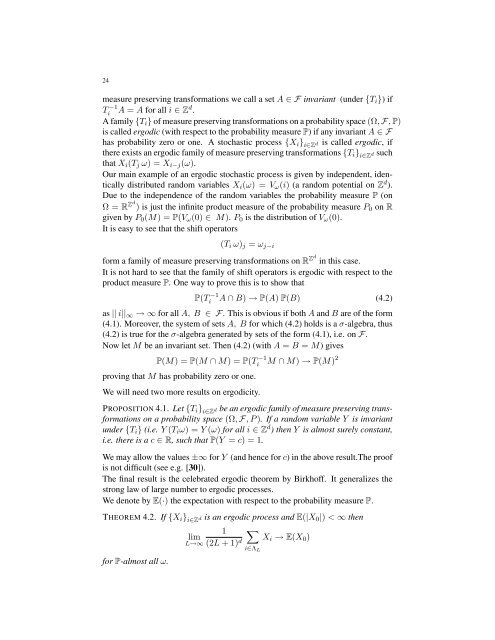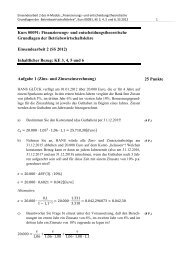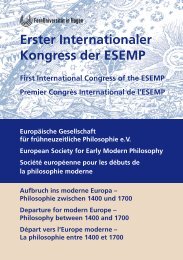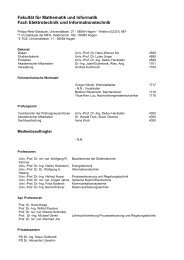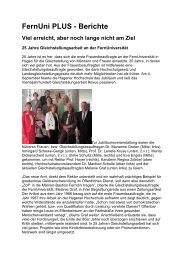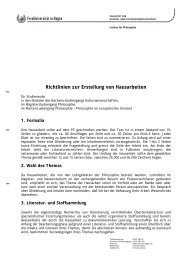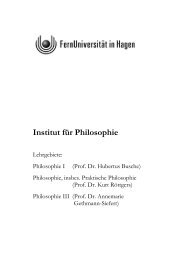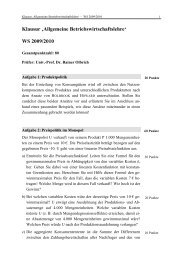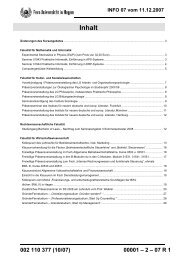An Invitation to Random Schr¨odinger operators - FernUniversität in ...
An Invitation to Random Schr¨odinger operators - FernUniversität in ...
An Invitation to Random Schr¨odinger operators - FernUniversität in ...
Create successful ePaper yourself
Turn your PDF publications into a flip-book with our unique Google optimized e-Paper software.
24<br />
measure preserv<strong>in</strong>g transformations we call a set A ∈ F <strong>in</strong>variant (under {T i }) if<br />
Ti −1 A = A for all i ∈ Z d .<br />
A family {T i } of measure preserv<strong>in</strong>g transformations on a probability space (Ω, F, P)<br />
is called ergodic (with respect <strong>to</strong> the probability measure P) if any <strong>in</strong>variant A ∈ F<br />
has probability zero or one. A s<strong>to</strong>chastic process {X i } i∈Z d is called ergodic, if<br />
there exists an ergodic family of measure preserv<strong>in</strong>g transformations {T i } i∈Z d such<br />
that X i (T j ω) = X i−j (ω).<br />
Our ma<strong>in</strong> example of an ergodic s<strong>to</strong>chastic process is given by <strong>in</strong>dependent, identically<br />
distributed random variables X i (ω) = V ω (i) (a random potential on Z d ).<br />
Due <strong>to</strong> the <strong>in</strong>dependence of the random variables the probability measure P (on<br />
Ω = R Zd ) is just the <strong>in</strong>f<strong>in</strong>ite product measure of the probability measure P 0 on R<br />
given by P 0 (M) = P(V ω (0) ∈ M). P 0 is the distribution of V ω (0).<br />
It is easy <strong>to</strong> see that the shift opera<strong>to</strong>rs<br />
(T i ω) j = ω j−i<br />
form a family of measure preserv<strong>in</strong>g transformations on R Zd <strong>in</strong> this case.<br />
It is not hard <strong>to</strong> see that the family of shift opera<strong>to</strong>rs is ergodic with respect <strong>to</strong> the<br />
product measure P. One way <strong>to</strong> prove this is <strong>to</strong> show that<br />
P(T −1<br />
i<br />
A ∩ B) → P(A) P(B) (4.2)<br />
as || i|| ∞ → ∞ for all A, B ∈ F. This is obvious if both A and B are of the form<br />
(4.1). Moreover, the system of sets A, B for which (4.2) holds is a σ-algebra, thus<br />
(4.2) is true for the σ-algebra generated by sets of the form (4.1), i.e. on F.<br />
Now let M be an <strong>in</strong>variant set. Then (4.2) (with A = B = M) gives<br />
P(M) = P(M ∩ M) = P(T −1<br />
i<br />
M ∩ M) → P(M) 2<br />
prov<strong>in</strong>g that M has probability zero or one.<br />
We will need two more results on ergodicity.<br />
PROPOSITION 4.1. Let {T i } i∈Z d be an ergodic family of measure preserv<strong>in</strong>g transformations<br />
on a probability space (Ω, F, P ). If a random variable Y is <strong>in</strong>variant<br />
under {T i } (i.e. Y (T i ω) = Y (ω) for all i ∈ Z d ) then Y is almost surely constant,<br />
i.e. there is a c ∈ R, such that P(Y = c) = 1.<br />
We may allow the values ±∞ for Y (and hence for c) <strong>in</strong> the above result.The proof<br />
is not difficult (see e.g. [30]).<br />
The f<strong>in</strong>al result is the celebrated ergodic theorem by Birkhoff. It generalizes the<br />
strong law of large number <strong>to</strong> ergodic processes.<br />
We denote by E(·) the expectation with respect <strong>to</strong> the probability measure P.<br />
THEOREM 4.2. If {X i } i∈Z d is an ergodic process and E(|X 0 |) < ∞ then<br />
1 ∑<br />
lim<br />
L→∞ (2L + 1) d X i → E(X 0 )<br />
i∈Λ L<br />
for P-almost all ω.


